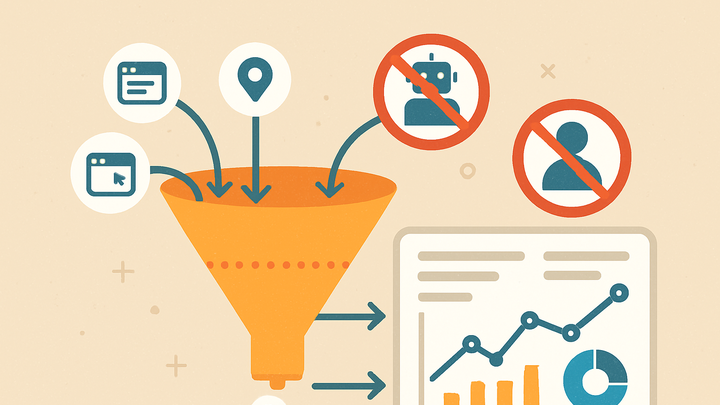Published on 2025-06-28T07:48:54Z
Data Filters: What Are They in Analytics? Examples in GA4 & PlainSignal
Data filters are configurable rules applied to your analytics dataset to include or exclude specific events, pageviews, or user interactions. They help remove unwanted traffic—like internal IPs, bots, or test events—to keep your reports clean and focused on genuine user behavior. In platforms like Google Analytics 4 (GA4), filters can be configured under Admin > Data Settings > Data Filters. Simple, cookie-free analytics solutions such as PlainSignal allow similar filtering capabilities through configuration flags or JavaScript-based criteria in the tracking snippet. Properly implemented data filters improve data quality, reduce noise, and ensure more accurate insights for decision-makers.
Data filters
Rules to include or exclude analytics data (e.g., internal traffic, bots) ensuring clean, accurate insights in GA4 and PlainSignal.
What Are Data Filters?
Data filters are rules that define which raw interaction data your analytics platform processes or ignores. They are essential for maintaining the integrity of your analytics by removing noise and focusing on meaningful user behavior. Without filters, metrics like pageviews, session counts, and conversion rates can be skewed by irrelevant traffic.
-
Purpose of data filters
Filters help you: (1) Exclude internal or test traffic. (2) Remove bot and spam referrals. (3) Focus on specific user segments or regions.
-
Excluding internal traffic
By filtering out your own team’s IP addresses, you prevent employee activity from inflating metrics.
-
Spam and bot removal
Automated crawlers and referral spam can distort your data. Filters help to eliminate these false interactions.
-
-
Impact on data quality
Well-defined filters ensure that your reports reflect actual customer behavior, leading to more trustworthy insights.
-
Improved decision-making
Clean data supports better analysis and strategic choices.
-
Reduced noise
Filtering out anomalies helps in identifying real trends.
-
Types of Data Filters
Analytics platforms support various filter types to suit different needs, from predefined templates to fully custom rules. Understanding the available options helps you apply the right filter for each use case.
-
Predefined system filters
Built-in filters provided by the analytics platform, often to exclude known bots or internal traffic.
-
Bot filtering
Automatically exclude known bot and spider traffic based on maintained lists.
-
Internal traffic exclusion
Apply IP-based filters using predefined settings to block your organization’s addresses.
-
-
Custom filters
User-defined rules based on dimensions, metrics, or event parameters.
-
Regex filters
Use regular expressions to include or exclude complex patterns like query parameters or hostname.
-
Event parameter filters
Filter based on custom parameters sent with events, such as user role or device type.
-
Implementing Data Filters in GA4 and PlainSignal
Different analytics solutions have unique interfaces and capabilities for filter setup. This section shows steps for both GA4 and the PlainSignal cookie-free analytics tool.
-
GA4 filter setup
In Google Analytics 4, navigate to Admin > Data Settings > Data Filters. You can enable system filters or create new custom filters using conditions on dimensions and event parameters.
-
Creating a custom filter
Click Create Filter, select filter type (e.g., Exclude internal traffic), define the match conditions, and save.
-
Testing filters
GA4 provides a debug view and a Test data stream to validate filters before applying them to production data.
-
-
PlainSignal cookie-free filtering
PlainSignal allows simple inclusion/exclusion by adjusting your tracking snippet or setting JavaScript flags.
-
Basic setup
Add the PlainSignal script to your site as usual. To exclude internal hosts or test environments, configure flags or parameters.
-
Code example
<link rel='preconnect' href='//eu.plainsignal.com/' crossorigin /> <script defer data-do='yourwebsitedomain.com' data-id='0GQV1xmtzQQ' data-api='//eu.plainsignal.com' src='//cdn.plainsignal.com/plainsignal-min.js'></script>
-
Best Practices and Considerations
Applying filters requires careful planning to avoid data loss and ensure continued accuracy. Follow these best practices to optimize filter usage.
-
Order of filters
Platform-specific order of filter execution can affect final output. Always test the sequence when multiple filters apply.
-
Execution sequence
Understand how filters are processed—some platforms apply system filters before custom ones.
-
-
Monitoring and maintenance
Regularly review your filters to adapt to changes in traffic patterns or site architecture.
-
Scheduled audits
Set a quarterly review to check filter effectiveness and adjust as needed.
-
Impact analysis
Compare included vs excluded traffic to ensure no critical data is being lost.
-
